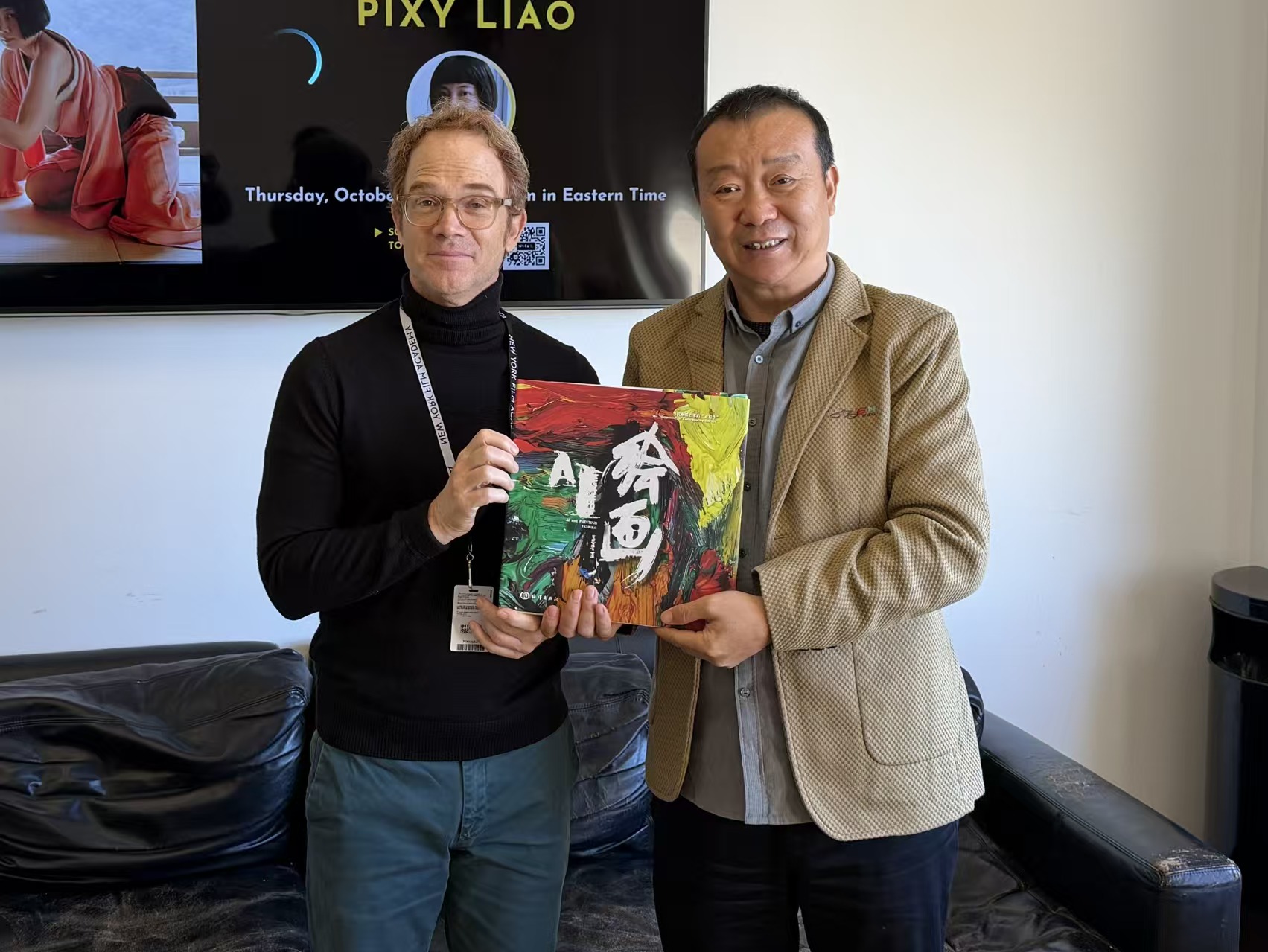

Michael Young, President of the New York Film Academy, collects Fan Beilu’s artwork.

Fan Beilu donated an art album to the library of the New York Film Academy.
In the multifaceted landscape of contemporary art, the dialogue between East and West remains a persistent undercurrent—revealing, through surface-level divergences, a shared human expression. The artistic practice of Mr. Fan Beilu is a profound and poetic unfolding along this very thread.
Explaining the meaning behind his pseudonym, Fan Beilu once noted: “Fan” is drawn from Van Gogh, whose passionate subjectivity he reveres; “Bei” refers to Xu Beihong, whose unrestrained exuberance he admires; and “Lu” evokes Lu Xun, whose lyrical satire he deeply respects. In the Chinese linguistic context, the name “Fan Beilu” also carries the resonance of “traversing East and West, experiencing worldly joys and sorrows, remaining true to one’s nature.”
This exhibition brings together Fan Beilu’s works in color ink and abstract oil painting—two seemingly disparate visual languages that together construct a spiritual bridge across cultural boundaries. It is not merely a juxtaposition of Eastern and Western artistic styles or a reconstruction of formal vocabularies, but a contemplative journey into existence, time, and civilization.
We may envision the exhibition space as an “in-between” zone of Eastern and Western artistic realms: the breathability of xuan paper and the tension of canvas overlap here; the diffusion of ink and the layering of oil paint mirror one another. As viewers enter, they become a third medium—their gaze lingers in the blank spaces, their bodies move through fields of color, and their thoughts are drawn into a dialectical corridor of “seeming non-action, yet profound action.”
Fan Beilu’s color ink paintings employ ink and xuan paper as media, yet transcend traditional boundaries, imbuing color with emotional warmth and metaphorical depth. The central figure in these works—a middle-aged man—is both a projection of the artist himself and a reflection of countless individuals in contemporary Chinese society. He walks with composure, his expression serene, maintaining a near-Zen tranquility amid worldly clamor: a silhouette, a pause, a contemplative gaze—all become visual annotations of the classical Chinese philosophical notion of “seeming non-action, yet profound action.”
The creative transformation of traditional blank-space techniques is the core allure of this series. The expanses of emptiness are not truly blank, but rather fields of flowing meaning: they may represent folds in time and space, externalizations of inner states, or the yet-unfolding trajectory of fate. This aesthetic of “calculating blankness as fullness” not only continues the poetic beauty of “residual mountains and waters” found in Song dynasty painters Ma Yuan and Xia Gui, but also resonates with the minimalist spirit of modernism. In an era dominated by the visual surplus of the internet and image economy, this pursuit of simplicity and allegorical depth reflects a profound humanistic critique. Through blankness, Fan Beilu guides the viewer’s gaze beyond the frame, inviting us to co-create meaning—an embodiment of Eastern aesthetics’ wisdom of “less is more, presence from absence.”
If the color ink series is an inward meditation, then Fan Beilu’s abstract oil paintings are an outward cry. These works feature bold color contrasts, thick textures, dynamic brushwork, and tension-filled compositions, accompanied by visual symbols such as “buildings,” “peace doves,” and “flying machines.” They directly address global issues like urbanization, environmental crisis, war, and peace—achieving a refined juxtaposition of materiality, spontaneity, and rational insight.
Though the artist adopts Western oil painting media and the formal vocabulary of abstract expressionism, the essence of his work remains steeped in Eastern cosmology. The collision and fusion of colors echo the dynamic balance of yin and yang in Chinese philosophy; the seemingly spontaneous yet controlled brushstrokes evoke the expressive spirit of calligraphy, where “intention precedes the brush.” Fan Beilu’s abstract oils are not superficial exercises in form, but visual manifestations of emotional and intellectual “flow.” In an age of AI-driven “mechanical reproduction of art” saturating popular culture, his return to the irreplaceable individual experience—perception, emotion, insight—is especially precious.
As viewers move through the gallery, they may sense the “weight” of oil paint lurking within the “emptiness” of ink, and the “lightness” of ink surfacing within the “density” of oil. These two aesthetics are no longer crudely juxtaposed cultural symbols, but through their material differences, achieve a subtle harmony of artistic perception and humanistic thought.
Fan Beilu’s artistic practice is a gentle yet resolute response to cultural identity and shared human destiny in the age of globalization. He neither clings rigidly to tradition nor drifts passively with trends, but instead carves out a spiritual domain at the intersection of Eastern and Western aesthetics through a unique visual language. His works invite us to pause our hurried steps, to contemplate life’s essence in the blank spaces, and to sense the pulse of our era in the interplay of color and form, image and emotion.
The world may be small, but the human heart is vast. Though this overseas solo exhibition is modest in scale, within the confines of the gallery and the dimensions of each piece, one can clearly perceive the brilliance of Fan Beilu’s character and talent. May every visitor who enters this space find their own answers in this journey of vision and thought, and in the dialogue between Eastern and Western civilizations, discover the universal emotions that transcend geography and time—the pursuit of beauty, the yearning for truth, and the steadfastness in goodness.
Huo Xiaoyan
October 7, 2025


